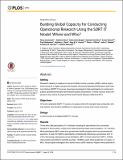Files in this item
Building global capacity for conducting operational research using the SORT IT model: where and who?
Item metadata
| dc.contributor.author | Zachariah, Rony | |
| dc.contributor.author | Rust, Stefanie | |
| dc.contributor.author | Berger, Selma Dar | |
| dc.contributor.author | Guillerm, Nathalie | |
| dc.contributor.author | Bissell, Karen | |
| dc.contributor.author | Delaunois, Paul | |
| dc.contributor.author | Reid, Anthony J. | |
| dc.contributor.author | Kumar, Ajay M. V. | |
| dc.contributor.author | Olliaro, Piero L. | |
| dc.contributor.author | Reeder, John C. | |
| dc.contributor.author | Harries, Anthony D. | |
| dc.contributor.author | Ramsay, Andrew | |
| dc.date.accessioned | 2016-08-24T15:36:22Z | |
| dc.date.available | 2016-08-24T15:36:22Z | |
| dc.date.issued | 2016-08-09 | |
| dc.identifier | 245264243 | |
| dc.identifier | 4e467188-10a1-4b3d-9711-37b645f46b8a | |
| dc.identifier | 84983643556 | |
| dc.identifier | 000381374200066 | |
| dc.identifier.citation | Zachariah , R , Rust , S , Berger , S D , Guillerm , N , Bissell , K , Delaunois , P , Reid , A J , Kumar , A M V , Olliaro , P L , Reeder , J C , Harries , A D & Ramsay , A 2016 , ' Building global capacity for conducting operational research using the SORT IT model: where and who? ' , PLoS One , vol. 11 , no. 8 , e0160837 . https://doi.org/10.1371/journal.pone.0160837 | en |
| dc.identifier.issn | 1932-6203 | |
| dc.identifier.other | RIS: urn:00919B9C64C8848642F160F0A9D198F9 | |
| dc.identifier.uri | https://hdl.handle.net/10023/9372 | |
| dc.description | This paper is an output of the Structured Operational Research and Training Initiative (SORT IT), a global partnership led by the Special Program for Research and Training in Tropical Diseases at the World Health Organization (WHO/TDR), Geneva, Switzerland. | en |
| dc.description.abstract | Setting. Research capacity is weakest in low and middle-income countries (LMICs) where operational research is highly relevant and needed. Structured Operational Research and Training Initiative (SORT IT) courses have been developed to train participants to conduct and publish operational research and influence policy and practice. Twenty courses were completed in Asia, Africa, Europe and the South Pacific between 2009 and 2014. Objectives. In the 20 completed SORT IT courses, to assess where the research was conducted, who was trained, who became facilitators in subsequent courses and course outcomes. Design. A cohort study of completed SORT IT courses. Results. There were 236 participants (41% female) including 64 nationalities who conducted research in 59 countries, mostly from Asia and Africa (mean course duration = 9.7 months). Most participants (68%) were from government health programs and non-governmental agencies. A total of 213(90%) participants completed all milestones successfully with 41(19%) becoming subsequent course facilitators, 88% of whom were from LMICs. Of 228 manuscripts submitted to scientific journals, 197(86%) were either published or in press; in 86%, the principal investigator (first author) was a LMIC national. Papers were published in 23 scientific journals (impact factor 0.5–4.4) and covered 21 disease categories (median publication time = 5.7 months). Published papers (186) had 94,794 cumulative article views/downloads. Article views/downloads for immediate open access articles were double those from closed access journals. Conclusion. The SORT IT model has been effective in training personnel to produce relevant operational research in LMICs. It merits continued commitment and support for further scale-up and development. | |
| dc.format.extent | 14 | |
| dc.format.extent | 985795 | |
| dc.language.iso | eng | |
| dc.relation.ispartof | PLoS One | en |
| dc.subject | RA Public aspects of medicine | en |
| dc.subject | NDAS | en |
| dc.subject.lcc | RA | en |
| dc.title | Building global capacity for conducting operational research using the SORT IT model: where and who? | en |
| dc.type | Journal article | en |
| dc.contributor.institution | University of St Andrews. School of Medicine | en |
| dc.identifier.doi | 10.1371/journal.pone.0160837 | |
| dc.description.status | Peer reviewed | en |
This item appears in the following Collection(s)
Items in the St Andrews Research Repository are protected by copyright, with all rights reserved, unless otherwise indicated.

